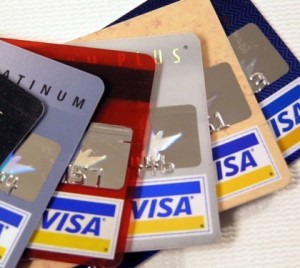
|

|

Some basic rules of interest rates
on credit-card debt include:
Interest rates are variable. Credit card rates
are set by adding a spread, or margin, to a base rate. Your base rate is often a widely used index rate, which is almost always a rate that changes periodically.
The spread that is added to calculate your rate depends on
your credit history. If you pay your bills consistently and on time, the spread may be as few as 2 or 3
percentage points. If your credit history reveals that you make late payments, or have too much debt, the spread may be 5
or 6 percentage points or more.
Rates are higher than those for secured loans.
Credit card rates are higher than those on home equity loans, in part, because they do not have collateral. Lenders face more risk in providing unsecured credit than they do with secured credit. If you are establishing or repairing credit, consider applying for a secured card.
The stated rate is not your actual interest rate. The advertised rate on a credit card is often the card's simple interest rate. The effective interest rate, however, is your true cost of borrowing. It should include annual fees you pay to use the card. The compounded interest rate is a better barometer of your effective interest rate. For example, if
your card has a rate of 12%, your monthly rate would be 1%. Because credit card interest is compounded monthly, the effective
annual interest rate on a 12% simple-rate card is 12.68%.
|

|

|

|

|

|
C'Mon. Give Yourself some Credit...
At Last, a credit card that turns poor credit into good credit.

CLick here to apply for a card that rebuilds your credit score.
Interest rates have a ceiling.
Credit cards generally have a maximum interest rate, or ceiling. If you are delinquent in making payments, your card company may seek to automatically impose the ceiling
rate, which can be devastating if you have thousands of dollars in card balances that are affected. Be sure to read the agreement
with your card company to see what your ceiling rate is (often, it is 21%), and what terms may result in you having to pay
the ceiling rate.
Some states have usury laws that limit the ceiling rate that lenders can charge borrowers in that state. For example,
Arkansas limits the ceiling rate on loans to 5 percentage points over the discount rate. As a result, Arkansas banks typically offer the lowest-rate credit cards in the nation.
Interest on credit card debt is not tax-deductible. Unlike a home equity loan, you cannot deduct the interest you pay on a credit card from your taxable income. Thus, if you are in
the 25% income tax bracket and have a 10% rate, your after-tax rate is also 10%. Your after-tax rate on a home
equity loan, however, is 7.5%.
|

|

|

|

|

|
| A better credit card is waiting. Search Here... |

|
Home
MyBestMortgageSite.com
Vantage Score
TopCreditRepairSecrets.com
Boost your credit score
Free Credit Report
Stop Creditor Calls
Fair Credit Report Act
Harassing Creditors-Fight back
Abusive Creditors-How to deal with them
Simple tips to Credit Repair
Chargeoffs
Credit Score Myths
Credit Cards that Rebuild credit
Credit Card Traps
Bad Credit Personal Loans
Divorce and Your Credit
Bad Credit Mortgage Refinance
Credit Rates 101
Sites we Like...
The 24 Hour Credit fix
|

|

|

